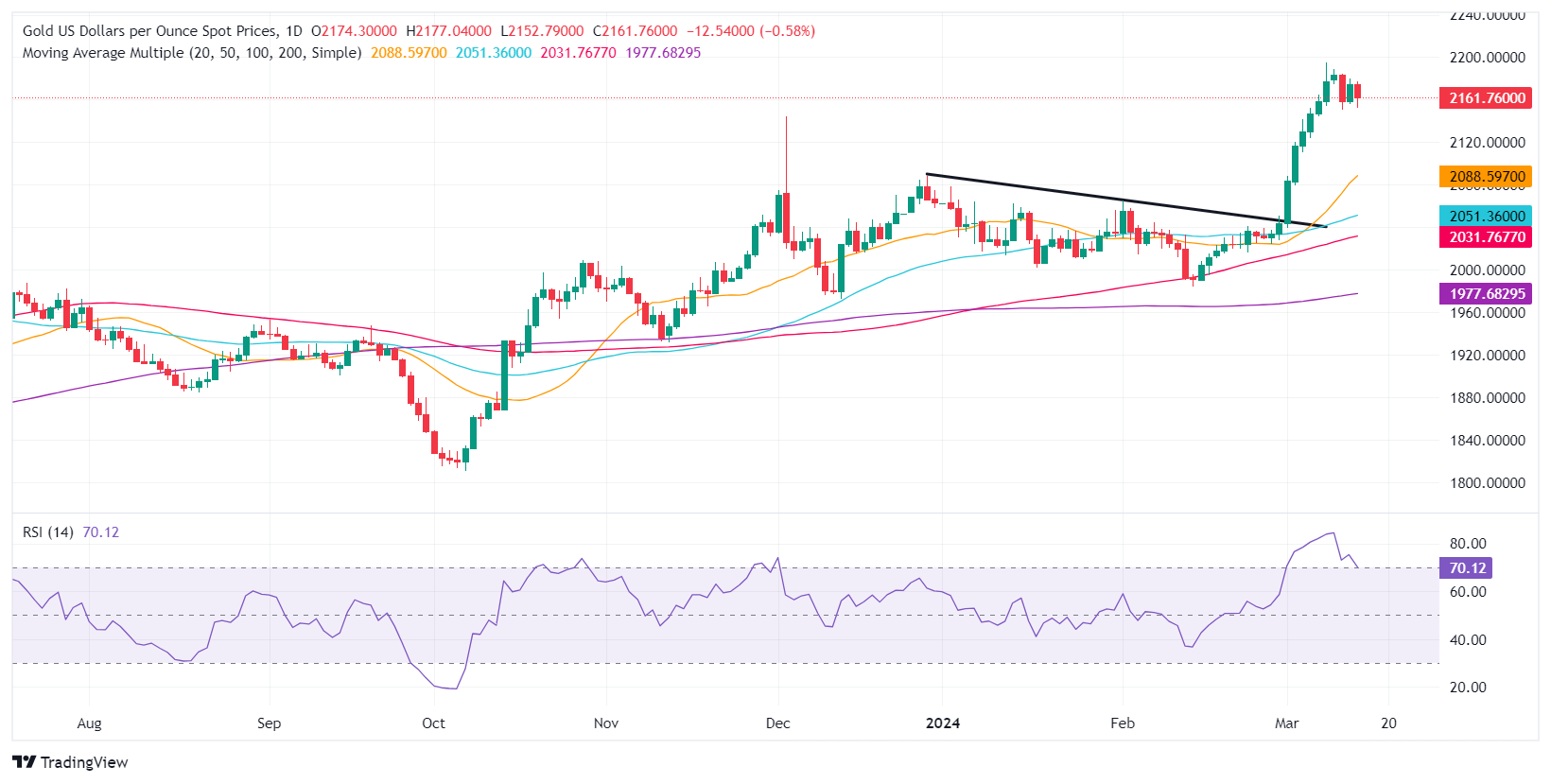- Gold is experiencing a partial decline in reaction to the unexpectedly high inflation of US producers and the strengthening of the Dollar.
- US Treasury yields and the Dollar Index rise, reflecting a market reassessment of the Federal Reserve's monetary policy.
- Retail sales and initial jobless claims data underscore the resilience of the US economy, weighing on intraday gold prices.
Gold prices pared back some of their Wednesday gains on Thursday after traders began pricing in a less “dovish” Federal Reserve following a hotter-than-expected Producer Price Index (PPI) report. Consequently, US Treasury yields rose, supporting the US dollar. At the time of writing, XAU/USD is trading around $2,160.00 and gaining 0.50%.
US stocks ended the session with losses. Previously, the US Department of Labor announced that a measure of inflation on the producer side jumped. At the same time, US retail sales showed that consumers remained resilient, while people filing for unemployment insurance fell below the previous reading and estimates.
Uncertainty over the policy outlook for U.S. central banks led investors to trim their bets that the Fed would cut rates at its June meeting. Meanwhile, the yellow metal remains afloat as the 10-year US Treasury yield rises ten basis points, from 4.19% to 4.29%, while the US Dollar Index (DXY), an indicator of The evolution of the dollar against other currencies rises 0.54%, up to 103.33 points.
Daily Market Summary: Gold on the Defensive Against USD Strength
- The PPI remained strong at 1.6% year-on-year, up from 0.9%, while the core PPI was unchanged at 2%, with both figures above consensus.
- The US Department of Commerce revealed that retail sales missed estimates of 0.8% mom and rose 0.6%, still an improvement compared to the previous month's reading of -1.1%.
- The labor market remained tense as initial jobless claims for the week ending March 9 fell from 210,000 to 209,000, below estimates of 218,000.
- In a context in which US consumer and production price indices show a revival of inflation, Fed officials should refrain from relaxing monetary policy.
- During his appearance last week before the US Congress, Fed Chairman Jerome Powell stated that inflation is cooling, while acknowledging that they could relax monetary policy at the end of the year. However, he stressed that this would depend on new data confirming to those responsible for monetary policy that inflation is moving steadily towards the 2% objective set by the Fed. The next Fed meeting is scheduled for the 19th. and March 20.
- According to CME's FedWatch tool, expectations for a rate cut in May remain low, having fallen from 22% to 11%. However, the odds for June stand at 64%, up from 72%.
Technical Analysis: Gold Buyers Take a Pause Below $2,170.00

Gold price remains biased higher on Thursday, but has consolidated near the $2,160-$2,180 area for the past three days, unable to break above the range and aim towards $2,200.00. It must be said that the Relative Strength Indicator (RSI) is about to pierce below 70, an indication that buyers are losing momentum. In that case, XAU/USD could fall towards $2,150.00.
The March 6 low at $2,123.80, followed by $2,100.00, could be the target for the decline. A break of the latter would expose the December 28 high at $2,088.48 and the February 1 high at $2,065.60.
On the other hand, a bullish continuation would occur once buyers reclaim the March 12 high at $2,184.76. The next stop would be the year-to-date high of $2,195.15, followed by $2,200.00.
Frequently asked questions about Gold
Gold has played a key role in human history, as it has been widely used as a store of value and medium of exchange. Today, aside from its brilliance and use for jewelry, the precious metal is considered a safe-haven asset, meaning it is considered a good investment in turbulent times. Gold is also considered a hedge against inflation and currency depreciation, since it does not depend on any issuer or government.
Central banks are the largest holders of Gold. In their aim to support their currencies in turbulent times, central banks tend to diversify their reserves and purchase Gold to improve the perception of strength of the economy and currency. High Gold reserves can be a source of confidence for the solvency of a country. Central banks added 1,136 tons of gold worth about $70 billion to their reserves in 2022, according to data from the World Gold Council. This is the largest annual purchase since records exist. Central banks in emerging economies such as China, India and Turkey are rapidly increasing their gold reserves.
Gold has an inverse correlation with the US Dollar and US Treasuries, which are the main reserve and safe haven assets. When the dollar depreciates, Gold tends to rise, allowing investors and central banks to diversify their assets in turbulent times. Gold is also inversely correlated with risk assets. A rally in the stock market tends to weaken the price of Gold, while sell-offs in riskier markets tend to favor the precious metal.
The price can move due to a wide range of factors. Geopolitical instability or fear of a deep recession can cause the price of Gold to rise rapidly due to its status as a safe haven asset. Being a non-yielding asset, Gold tends to rise with lower interest rates, while the higher cost of money usually weighs on the yellow metal. However, most of the movements depend on the behavior of the US dollar (USD), as the asset is traded in dollars (XAU/USD). A strong dollar tends to keep the price of Gold in check, while a weaker dollar is likely to push up Gold prices.
Source: Fx Street
I am Joshua Winder, a senior-level journalist and editor at World Stock Market. I specialize in covering news related to the stock market and economic trends. With more than 8 years of experience in this field, I have become an expert in financial reporting.







